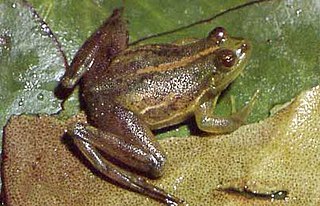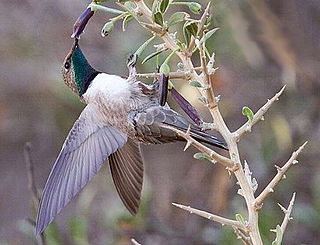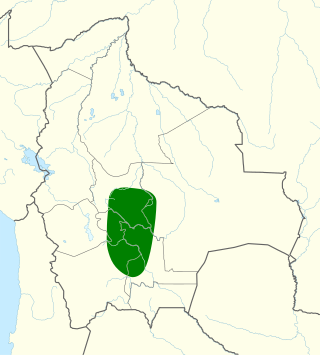
The International Union for Conservation of Nature (IUCN) Red List of Threatened Species, also known as the IUCN Red List or Red Data Book, founded in 1964, is an inventory of the global conservation status and extinction risk of biological species. A series of Regional Red Lists, which assess the risk of extinction to species within a political management unit, are also produced by countries and organizations.

Lysapsus is a genus of frogs in the family Hylidae found in South America east of the Andes. Their common name is harlequin frogs.

A species that is extinct in the wild (EW) is one that has been categorized by the International Union for Conservation of Nature as only consisting of living members kept in captivity or as a naturalized population outside its historic range. Classification requires exhaustive surveys conducted within the species' known habitat with consideration given to seasonality, time of day, and life cycle. Once a species is classified as EW, the only way for it to be downgraded is through reintroduction.

The Andean hillstar is a species of hummingbird in the "coquettes", tribe Lesbiini of subfamily Lesbiinae. It is found in Argentina, Bolivia, Chile, and Peru.

The great-billed hermit is a species of hummingbird in the family Trochilidae. It is found in Bolivia, Brazil, Colombia, Ecuador, French Guiana, Peru, Suriname, and Venezuela.
Ameerega boliviana, formerly Epipedobates bolivianus, is a species of frog in the family Dendrobatidae endemic to Bolivia. Its natural habitats are subtropical or tropical moist montane forests, rivers, freshwater marshes, intermittent freshwater marshes, pastureland, rural gardens, and heavily degraded former forests.
Lysapsus caraya is a species of frog in the family Hylidae found in central and southern Brazil. Its common name is Mato Verde harlequin frog.
Lysapsus laevis is a species of frog in the family Hylidae found in southwestern Guyana and adjacent northern Brazil. Common name Guyana harlequin frog has been coined for this species.

Lysapsus limellum, sometimes known as the Uruguay harlequin frog, is a species of frog in the family Hylidae found in northern Argentina, Bolivia, Brazil, Paraguay, and Uruguay. Its natural habitats are moist savanna, subtropical or tropical seasonally wet or flooded lowland grassland, rivers, swamps, freshwater lakes, freshwater marshes, and pastureland. It is locally impacted by habitat loss.

Leptodactylus bolivianus is a species of frog in the family Leptodactylidae. Its local name is sapo-rana boliviano.
Telmatobius bolivianus is a species of frog in the family Telmatobiidae. It is endemic to the Eastern Andes of Bolivia. It was formerly the most common and widespread Telmatobius of Bolivia, but has had a drastic population decline since the mid-2000s. It is an aquatic frog occurring in fast-flowing rivers and streams in cloud forest and Yungas forest. It is threatened by chytridomycosis as well as habitat loss caused by logging and agricultural expansion. Water pollution and aquaculture are also threats.

The white-eyed attila or dull-capped attila is a species of bird in the passerine family Tyrannidae, the tyrant flycatchers. They are found in Bolivia, Brazil, Colombia, Peru, and possibly Ecuador. Its natural habitat is subtropical or tropical swamps. It can be found at altitudes as high as 300 m (980 ft).

The Bolivian blackbird is a species of bird in the family Icteridae. It is monotypic within the genus Oreopsar.

The riverbank warbler, sometimes known as the Neotropical river warbler or just river warbler, is a species of bird in the family Parulidae.

The Bolivian tapaculo is a species of bird in the family Rhinocryptidae. It is found in Bolivia and Peru.

The moustached wren is a species of bird in the family Troglodytidae. It is found in Bolivia, Brazil, and Peru.

The Bolivian tyrannulet is a species of bird in the family Tyrannidae. It is found in Bolivia and Peru. Its natural habitat is subtropical or tropical moist montane forests.

The foothill screech owl is a species of owl in the family Strigidae. It is found in Bolivia, Brazil, Colombia, Ecuador, Guyana, Suriname, and Venezuela.
Proctoporus bolivianus, the Bolivian lightbulb lizard , is a species of lizard in the family Gymnophthalmidae. It is found in Bolivia and Peru.
Ancistrus bolivianus is a species of catfish in the family Loricariidae. It is native to South America, where it occurs in the basins of the Beni River, the Mamoré River, and the Madre de Dios River. The species reaches 8.8 cm SL.













